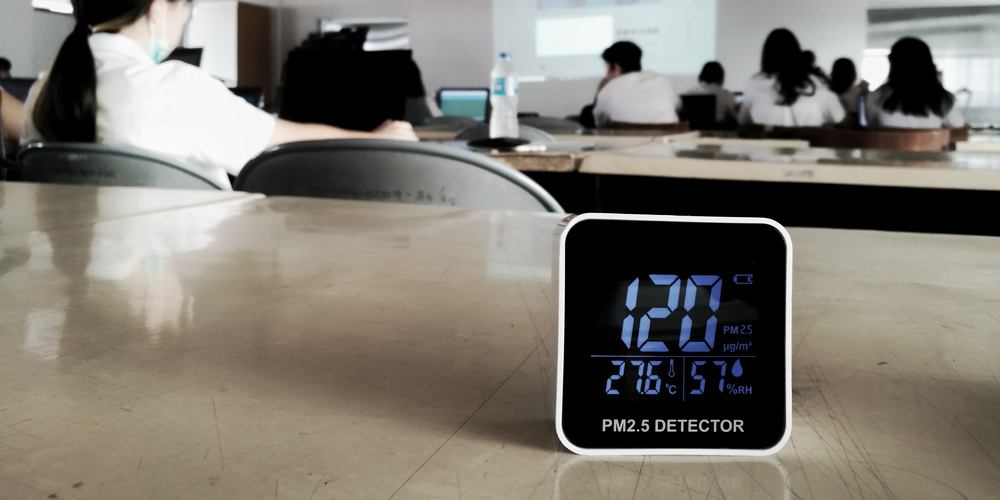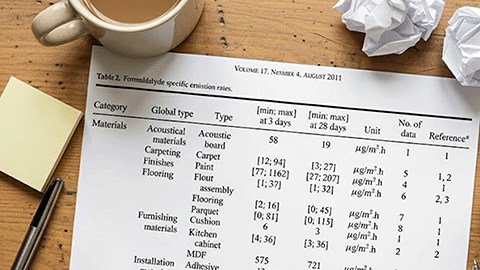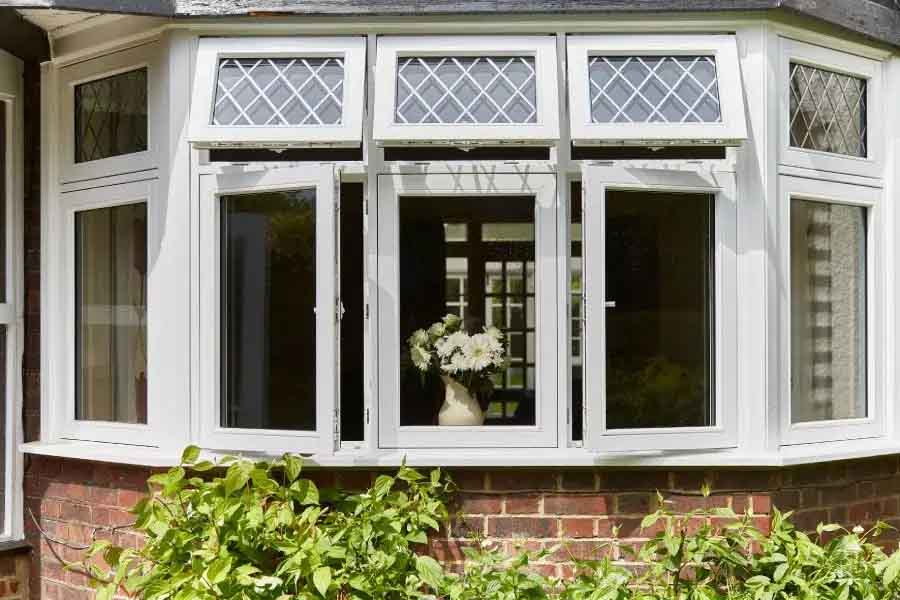The Ultimate Guide to Workplace IAQ Sensors 2024
This is our guide to the different types of indoor air quality sensors and monitors available, the parameters they measure, how to calibrate them for accuracy and consistency, and how to optimise their frequency of data transmission.
Contents:
- IAQ Sensor Types & Parameters
- IAQ Sensor Accuracy
- Sensor Calibration
- Data Transmission Rates
- What to Do With Your IAQ Data
IAQ Sensor Types and Parameters
What should an IAQ monitor measure? Most low-cost sensors and healthy building standards focus on the following set of variables:
- Temperature
- Humidity
- Particulate Matter (PM)
- Volatile Organic Compounds (VOCs)
- Carbon Dioxide (CO2)
For the health-recommended thresholds for pollutants monitored by IAQ sensors, see our article: Demystifying UK Indoor Air Quality Guidelines for Workplaces
Sensor types can be separated into two broad categories:
- Chemical sensors detect gaseous pollutants by changes in electrical signals.
- Low-cost sensors offer affordable options for common parameters like CO2, VOCs, and Particulate Matter.
Each of these sensors has different mechanisms of action suited to the specific pollutant they detect. Chemical sensors, for instance, may use electrochemical cell technology to identify gases like CO and NO2, while optical methods such as infrared gas analysers are often employed for CO2 measurement.
Monitors measure concentrations of airborne particulate matter and gases, providing data that can guide actions to improve indoor air quality. They can inform users when levels exceed health-recommended thresholds or when ventilation is necessary to reduce concentration levels.
By quantifying levels of pollutants, these devices help to identify potential health risks and facilitate proactive management of indoor air quality, with implications for comfort, health, and well-being.
Selecting the right sensors and monitors
Selecting the right IAQ sensors is crucial to ensure accurate monitoring of indoor environments. The choice is broad, including:
- Particulate matter sensors for detecting particles like PM1, PM2.5 and PM10. These particulates can penetrate deep into the respiratory system, causing health issues.
- VOC sensors for volatile organic compounds, a wide spectrum of organic chemical emissions from products and materials. E.g. benzene (from cigarette smoke and broken fuel burning appliances) and formaldehyde (from paint, wood resins and old building materials).
- VOC measuring equivalent CO2 sensors for approximating carbon dioxide levels.
- NDIR (Non-Dispersive Infrared) CO2 sensors for stable long-term readings.
- MOS (Metal-Oxide Semiconductor) sensors, which are cost-effective and provide data on crucial parameters such as temperature, humidity and the presence of various air pollutants, which are essential for maintaining clean air in occupiable spaces like offices, homes, and especially sensitive environments such as hospitals.
Impact of pollutants in the workplace
Environmental factors such as humidity, temperature, and external air pollution heavily affect indoor air quality. For instance, humidity levels can encourage mould growth when too high or cause irritation and respiratory problems when too low. The opening and closing of windows also play a critical role in ventilating indoor spaces to balance indoor air pollutants with fresh air, thus maintaining air quality. Additionally, volatile organic compounds (VOCs) often emanate from building materials and furnishings, contributing to the pollutant load within an indoor environment.
The quality of air in indoor environments has profound implications for cognitive performance and can lead to symptoms such as fatigue. Poor IAQ, with elevated levels of contaminants like carbon monoxide, radon, and formaldehyde, can trigger a range of health issues from headaches to long-term respiratory conditions. During the COVID-19 pandemic, the role of IAQ was magnified, highlighting the transmission of viruses and the importance of adequate ventilation in reducing spread.
Technological and Methodological Advances in IAQ Monitoring
Recent advances in IAQ monitoring tools, like Kaiterra’s modular sensor and NDIR sensors, allow for continuous data collection on the concentration range of various gases including nitrogen and carbon dioxide. These devices have improved in providing accurate data, crucial for effective source control. Data analysis techniques have also evolved, offering more nuanced insights into IAQ and allowing for proactive rather than reactive management of indoor air pollutants.
How Accurate Are IAQ Sensors?
The performance of air quality monitors hinges on their ability to deliver precise and reliable data. Essential to the effectiveness of these devices are their accuracy and consistency, as well as the various external factors that might influence their readings.
IAQ sensors can vary significantly in accuracy depending on factors such as their design, calibration and the specific pollutants they're designed to detect. Generally, they can provide useful insights into air quality trends and relative changes over time, but their accuracy may not always match laboratory-grade equipment.
Factors such as sensor drift, cross-sensitivity to other pollutants, and environmental conditions (humidity, temperature, etc.) can affect the accuracy of IAQ sensors over time.
Accuracy and consistency of monitors
Accuracy is vital for ensuring safety and preventing health problems associated with poor air quality, such as respiratory issues. Indoor air quality monitors should be placed within the 'breathing zone' — around 0.9-1.8 metres off the floor — to optimise sensing of the air humans breathe. For indoor environments, selecting the right features, such as sensors capable of detecting radon levels or volatile organic compounds (VOCs), is crucial.
Consistency is as critical as accuracy. It is the ability of the air quality monitor to provide stable readings over time. Variability in monitor readings can be assessed through co-location studies, a process where a monitor's readings are compared against those from a regulatory reference instrument to determine baseline accuracy and calibration needs. Calibrated data from devices like the AQY1 monitors in this study, for instance, show varying degrees of consistency, indicating that some monitors might require frequent recalibration to maintain accuracy.
Most commercially available sensors are aligned with the RESET standard.The UL 2905 Environmental claim procedure is another sensor standard, but it has seen few adopters so far.
Factors affecting performance
Multiple factors can impede the performance of an air quality monitor. Pressure changes, ventilation rates, and moisture levels all have the potential to skew sensor readings. To compensate, many devices are designed with features to adjust to such environmental changes, enhancing the robustness of their data. Specialised monitors are used to detect specific contaminants such as radon, which requires distinct sensing technology due to its radioactive nature.
Another key element is calibration. Over time, sensors can drift and lose accuracy, making regular calibration against reference standards necessary to ensure performance. Manufacturers might recommend specific calibration intervals and procedures to uphold monitor functionality.
Ensuring air quality monitors are accurately reading and reporting on pollutants is essential for maintaining indoor environmental quality and safeguarding occupants' health.
Calibrating IAQ Sensors and Monitors
With IAQ sensors, calibration adjusts the sensor output to align with a reference standard. The calibration process typically follows these steps:
- Reference comparison: Sensors are exposed to known concentration levels of contaminants in controlled environments.
- Zero-point calibration: Involves setting the IAQ monitor to a baseline where no pollutants are present. This typically requires a controlled environment or clean air to establish the zero-point reference, which the monitor's sensor then uses as a base for measuring pollutants.
- Adjustment: Any discrepancy between the sensor reading and the known value is rectified.
- Validation: Post-calibration, sensors are rechecked to confirm improved accuracy.
Over time, the accuracy of IAQ sensors can drift, necessitating regular checks and recalibration to maintain their efficacy. Regular calibration of IAQ sensors accounts for environmental changes and sensor ageing, ensuring the readings remain representative of the air quality, and protects against the gradual sensor degradation that can occur with various contaminants.
Manufacturers recommend calibration in specific intervals or conditions to maintain sensor performance.
- WELL certification requires annual calibration or replacement sensors
- Kaiterra suggest replacement every 18 months.
Some IAQ sensors claim they can run automatic background calibrations that adapt to their environment, enhancing the consistency and reliability of readings. However, in reality these are remote data corrections, and cannot replace physical calibrations for long-term accuracy, as it’s not possible to properly calibrate a sensor without a known reference to compare it to.
Sensors such as the Kaiterra commercial sensors are modular in design, meaning they can calibrate the sensor for each parameter individually, without having to send the entire device for calibration.
The sophistication of the calibration process impacts the overall sensor accuracy and is a critical aspect for users who rely on precise IAQ data for health and safety decisions.
During calibration, each monitor's readings are compared against a known reference in a controlled setting, reflecting conditions similar to its intended application. Devices like a beta attenuation mass (BAM) monitor are highly precise instruments typically used in calibrating IAQ equipment due to their stringent performance criteria.
IAQ Sensor Data Transmission Rates
The standard data transmission rate for IAQ sensors varies depending on the specific type and model of the sensor, as well as the system configuration. However, the ideal state is for sensors to transmit data in near-real-time to enable prompt analysis and action.
Indoor air quality should be continuously monitored to ensure that the environmental conditions remain within safe and healthy levels. This allows for the timely identification and correction of any issues that may arise.
Example IAQ sensor data transmission rates:
- Battery-powered sensors tend to export data less often to save energy
- Kaiterra Sensedge pushes data every 1 minute
- Awair Omni summarises data and pushes every 5 minutes
- Airthings View Plus samples all parameters instantaneously every 5 minutes then pushes the data. (battery powered)
Sensor network architecture
The architecture of sensor networks for indoor air quality monitoring is a critical foundation for achieving reliable data transmission and integration in the Internet of Things (IoT) ecosystem. It empowers real-time monitoring and health risk assessments by accurately conveying environmental sensor data to cloud platforms for analysis.
What to do with your IAQ data
Read full article: What to Do With Your Indoor Air Quality (IAQ) Data
When IAQ sensors are distributed properly throughout your building and transmitting air quality data, the question is what to do with it. Here’s how you can turn the data you get from your IAQ sensors into actionable insights.
- Integrate with BMS: With real-time monitoring and control of HVAC systems based on IAQ conditions, you can get instant alerts from sensors to your building management systems. Building managers can identify areas that require improvement and take necessary actions to maintain healthy indoor air quality.
- Long-term trends analysis: By collecting IAQ data over time, trends in air quality can be identified. This information can guide long-term planning and improvements to building design and operations.
And here are some of the actions you can take with IAQ data-backed insights.
- Optimising ventilation: Monitors displaying high CO2 levels can pinpoint locations with poor ventilation, so you can either open windows or optimise mechanical ventilation systems.
- Maintaining HVAC system performance: IAQ sensors that display poor air can show where your HVAC is failing – fans, filters, ionisers, coils, UV lights – and help you stay efficient with maintenance.
Identify pollutant sources: By analysing pollutant levels and correlating them with activities or events, you can pinpoint potential pollution sources and take corrective actions.






